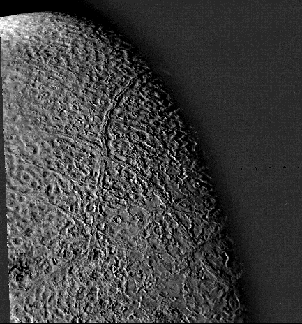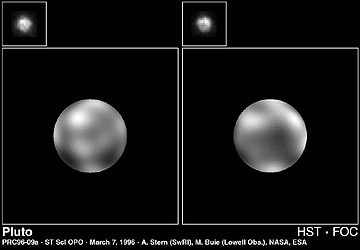

Neptune has six small satellites - irregular in shape and mostly rock - and one, Triton, farthest out and much larger (2700 km [1677] diameter) than the others. Triton moves in a retrograde circular orbit, i.e., moves (looking down from north) in a clockwise direction compared to the counterclockwise rotation of Neptune itself and its other satellites. Triton's axis of rotation is tilted 157° relative to its parent's axis. These unusual conditions are cited as evidence either of capture or of assembly after a collision, possibly influenced by interactions with Pluto as that small body periodically orbits inside Neptune's orbit.
The full view (top) of Triton reveals it to be very different from most of the Giant planets' satellites. This satellite has a brownish pink color, has a polar cap (bottom), and a structured surface. The color may be due to frozen nitrogen and/or the effects of methane.


Triton's density (2.06 gm/cc) indicates it to be a mix of (predominant) rock and ice. But its surface shows not only rocky features but evidence of water ice (?), and frozen methane and nitrogen (both would be solid at a surface temperature of -235 °C (35 °K]) in deposits that have built up an ice cap covering much of its southern hemisphere. Triton also has a very thin atmosphere (0.014 millibar) extending out to 800 km (499 miles). The south polar ice cap appears mottled, with dark areas perhaps showing rocks exposed along wind streaks where gases has sublimed:

Triton's surface contains ridges, fault valleys, occasional impact craters and, of notable interest, ice "volcanoes" in which liquid nitrogen and/or methane vaporizes in plumes or geyser-like jets at the surface carrying along particulates that form deposits on the ice cap.
Fractured terrains on Triton can take on a "texture" like the surface of a cantaloupe (top) or appearing as a series of oval features controlled by ridges (bottom):


The last planet in our solar system, Pluto, is not much different in diameter (~2340 km [1453 miles]) than Triton. It has yet to be visited by any space probe, although one (Pluto Express) has been proposed for early next century. First discovered (though its existence had been predicted) in 1930 by Dr. Clyde Tombaugh through the large telescope at the Lowell Observatory in Flagstaff, AZ, the best pictures (from HST) today show it to be a mix of very dark (organic?) and light zones of unknown nature;

its density suggests mostly rock with some ices (nitrogen, methane, water) from which an extremely tenuous atmosphere has evaporated.
Pluto's orbit is so eccentric that at times its path lies inside that of Neptune's. Its orbital period is 1.5x that of Neptune, with which it is locked in a 3:2 resonance. Pluto itself is orbited by a relatively large satellite, Charon, whose diameter (1260 km [782 miles]) makes it just half that of its parent (one opinion considers the two to be a double planet), with which it is in synchronous rotation.
Code 935, Goddard Space Flight Center, NASA
Written by: Nicholas M. Short, Sr. email: nmshort@epix.net
and
Jon Robinson email: Jon.W.Robinson.1@gsfc.nasa.gov
Webmaster: Bill Dickinson Jr. email: rstwebmaster@gsti.com
Web Production: Christiane Robinson, Terri Ho and Nannette Fekete
Updated: 1999.03.15.